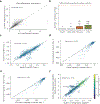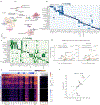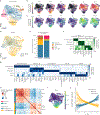Joint probabilistic modeling of single-cell multi-omic data with totalVI
- PMID: 33589839
- PMCID: PMC7954949
- DOI: 10.1038/s41592-020-01050-x
Joint probabilistic modeling of single-cell multi-omic data with totalVI
Abstract
The paired measurement of RNA and surface proteins in single cells with cellular indexing of transcriptomes and epitopes by sequencing (CITE-seq) is a promising approach to connect transcriptional variation with cell phenotypes and functions. However, combining these paired views into a unified representation of cell state is made challenging by the unique technical characteristics of each measurement. Here we present Total Variational Inference (totalVI; https://scvi-tools.org ), a framework for end-to-end joint analysis of CITE-seq data that probabilistically represents the data as a composite of biological and technical factors, including protein background and batch effects. To evaluate totalVI's performance, we profiled immune cells from murine spleen and lymph nodes with CITE-seq, measuring over 100 surface proteins. We demonstrate that totalVI provides a cohesive solution for common analysis tasks such as dimensionality reduction, the integration of datasets with different measured proteins, estimation of correlations between molecules and differential expression testing.
Figures















References
Publication types
MeSH terms
Substances
Grants and funding
LinkOut - more resources
Full Text Sources
Other Literature Sources
Molecular Biology Databases

